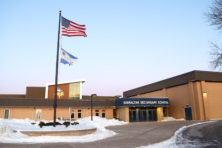Waterfront Debates Resolved in 2010
- Share
- Tweet
- Pin
- Share
In a community surrounded by water, shoreline issues are always at the center of public debate. Sometimes it’s the rise and fall of the water level, sometimes it’s the quality of that water. In 2010, public access to the shoreline, and the cost of creating it, stirred the pot as much as any other topic.
In Egg Harbor the village finally got closure on a four-year-old controversy over the reconstruction of its public marina. The year started ominously, as a tug being used to aid in reconstruction sank next to the marina. But on Aug. 14, a little more than a year after voters approved the project in a referendum, the $6.5 million marina finally opened to the public.
The marina and harbor of refuge features 63 slips, handicap accessibility, and natural storm water runoff filtration.
Down the shoreline from the marina Egg Harbor saw its public beach expansion pay off in a big way. The beach known to most as Alpine Beach attracted throngs of people all summer long.
In 2007 the village paid $1.6 million for the neighboring Troup property, adding 150 feet of beach. But that section of shoreline was separated from the rest by a large rock jetty and other rubble. For about $70,000, the village was able to create an entirely new look at the beach and park by removing the jetty, adding sand, and planting grasses to filter stormwater runoff.
Like Egg Harbor, the Town of Liberty Grove took plans for a public waterfront project to its voters, but in Liberty Grove voters balked.
Five years of arguments over the future of the Gills Rock shoreline came to a head in September, when the town brought a proposal to buy three waterfront parcels to its residents. The parcels included 431.5 feet of shoreline and 2.22 acres, with an asking price of $2,350,000.
The vote attracted the largest turnout for a municipal meeting that anyone could remember, drawing nearly 450 people to a meeting that had to be held in the town’s highway shop garage to accommodate the crowd. In the end, voters resoundingly rejected the measure in the purest form of direct democracy one could imagine.
Just a few miles south of Liberty Grove, however, the Village of Sister Bay went in another direction. Generations of village leaders have talked of creating a public waterfront, and when the Al Johnson family asked the village to make an offer on the last piece of its Waterfront Park puzzle, the village board decided it had to strike.
Many were stunned at the price tag – $5 million for a property assessed at $3.12 million – but the board felt it was worth the price to link 1,936 feet of continuous shoreline from the public marina to the village beach. The 1-acre property that was the home to the Al Johnson’s Butik included 292 feet of shore frontage and a 26-slip marina as well.
“This is the missing link between two ends of the village waterfront,” said Administrator Bob Kufrin. “Any redevelopment of the waterfront can’t happen without the Al’s property or their cooperation.”
As the year inched to a close, the butik building was torn down, opening up the last private piece of the shoreline to the public. Now officials, and the business community, wait anxiously to see if 2011 is the year businesses begin investing in expansion across the street from the waterfront.
Amidst all the noise that came with these waterfront projects, two other developments slid mostly under the radar. On the lake side of Liberty Grove, the Wisconsin Department of Natural Resources anteed up $1.05 million to buy 860 feet of shoreline on Rowleys Bay from the Rowleys Bay Resort. It includes a 14-slip marina, boat launch, and fishing pier and provides public access to the lake, a harbor of refuge, and access to the Mink River Estuary.
In Baileys Harbor the community began reviewing plans to improve Anclam Park, besieged in recent years by cladophora build-up and invasive species. A plan to improve the beach and spruce up the long jetty was presented in September, with conversations expected to continue early next year.

